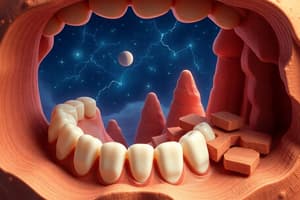Podcast
Questions and Answers
What is the initial step in the blow molding process for glass?
What is the initial step in the blow molding process for glass?
Which process involves rotating a mold to shape the glass by centrifugal force?
Which process involves rotating a mold to shape the glass by centrifugal force?
What determines the final thickness of the glass in the rolling process?
What determines the final thickness of the glass in the rolling process?
What is the purpose of reheating glass during the blow molding process?
What is the purpose of reheating glass during the blow molding process?
Signup and view all the answers
During which process is molten glass spread across a molten tin bath?
During which process is molten glass spread across a molten tin bath?
Signup and view all the answers
What is the primary reason tempered glass is preferred over annealed glass?
What is the primary reason tempered glass is preferred over annealed glass?
Signup and view all the answers
What process does the manufacturing of tempered glass involve to increase its strength?
What process does the manufacturing of tempered glass involve to increase its strength?
Signup and view all the answers
Which of the following is NOT a characteristic of ceramics design?
Which of the following is NOT a characteristic of ceramics design?
Signup and view all the answers
How is laminated glass constructed?
How is laminated glass constructed?
Signup and view all the answers
What is a main disadvantage of the machining process for ceramics?
What is a main disadvantage of the machining process for ceramics?
Signup and view all the answers
What is the process called where a suspension of ceramic powders in water is poured into a porous mold?
What is the process called where a suspension of ceramic powders in water is poured into a porous mold?
Signup and view all the answers
What is the typical water composition in a slip casting mixture?
What is the typical water composition in a slip casting mixture?
Signup and view all the answers
Which shaping process utilizes a very plastic mixture, primarily consisting of clay and water?
Which shaping process utilizes a very plastic mixture, primarily consisting of clay and water?
Signup and view all the answers
What occurs after the preblended granular materials are placed into an extruder?
What occurs after the preblended granular materials are placed into an extruder?
Signup and view all the answers
What is the main purpose of the plaster mold used in slip casting?
What is the main purpose of the plaster mold used in slip casting?
Signup and view all the answers
What is the primary characteristic of the mixtures used in plastic forming methods for ceramics?
What is the primary characteristic of the mixtures used in plastic forming methods for ceramics?
Signup and view all the answers
Which method is described as placing a preform slug into a mold for further deformation?
Which method is described as placing a preform slug into a mold for further deformation?
Signup and view all the answers
Which of the following processes is NOT typically used for shaping ceramics?
Which of the following processes is NOT typically used for shaping ceramics?
Signup and view all the answers
What is the purpose of jiggering in the ceramics process?
What is the purpose of jiggering in the ceramics process?
Signup and view all the answers
What percentage of water typically remains in the plastic mixture of clay and water during plastic forming?
What percentage of water typically remains in the plastic mixture of clay and water during plastic forming?
Signup and view all the answers
Which process helps in forming long sections of ceramics before being cut to required lengths?
Which process helps in forming long sections of ceramics before being cut to required lengths?
Signup and view all the answers
What happens to the dimensions of ceramic parts during the drying process?
What happens to the dimensions of ceramic parts during the drying process?
Signup and view all the answers
What is a primary function of sintering in the ceramics process?
What is a primary function of sintering in the ceramics process?
Signup and view all the answers
Which of the following methods is NOT part of the plastic forming techniques?
Which of the following methods is NOT part of the plastic forming techniques?
Signup and view all the answers
What is one of the primary uses for the extrusion process in ceramics?
What is one of the primary uses for the extrusion process in ceramics?
Signup and view all the answers
What main factor impacts the size of ceramics after the firing process?
What main factor impacts the size of ceramics after the firing process?
Signup and view all the answers
What is a primary characteristic of ceramics in terms of deformation?
What is a primary characteristic of ceramics in terms of deformation?
Signup and view all the answers
Which type of forces can ceramics withstand?
Which type of forces can ceramics withstand?
Signup and view all the answers
What distinguishes new ceramics from traditional ceramics?
What distinguishes new ceramics from traditional ceramics?
Signup and view all the answers
What is one of the primary methods used to prepare materials for ceramics?
What is one of the primary methods used to prepare materials for ceramics?
Signup and view all the answers
Which of the following describes the 'green' shape in ceramic processing?
Which of the following describes the 'green' shape in ceramic processing?
Signup and view all the answers
What is slip casting used for in ceramic production?
What is slip casting used for in ceramic production?
Signup and view all the answers
Which property is generally true for crystalline ceramics compared to metals?
Which property is generally true for crystalline ceramics compared to metals?
Signup and view all the answers
What is a key part of the finishing process in ceramic production?
What is a key part of the finishing process in ceramic production?
Signup and view all the answers
Study Notes
Ceramics
- Crystalline ceramics are similar to powder metals, but brittle, withstanding compressive but not tensile forces.
- Crystalline structures have higher melting points than metals.
- Ceramics include traditional (natural minerals) and new (synthetic) types, including cutting tools and artificial bones.
Ceramic Processing
- Raw Materials (Traditional): Starting material is a plastic paste, consistency affects forming and product quality. Crushing and grinding reduce particle size.
- Raw Materials (Plastic): Malleable materials that can be molded.
- Materials processing (Synthetic): Materials are natural or synthetically mined.
- Steps: Crushing, milling, forming (green shape), drying, firing (sintering), and finishing.
- Forming: Green shaping (weak), based on crystalline, clay, or glass types, used for classifying families.
- Sintering: Firing, causes glass and other heat treatments
- Slip Casting: Creating green shapes using a slurry of ceramic powder in water, suitable for crystalline and some clay-based ceramics.
Ceramics: Clay-based, and Viscous Crystalline Mixtures
- Plastic Forming (extrusion): Applied forces deform clay and water mixture. Granular materials are compacted into a pre-form slug for shaping in a mold. Used for producing tubes, bricks, and specific shapes.
- Plastic Forming (Jiggering): Mechanized potter's wheel that rotates with hand or motor, used for uniform shapes production.
Ceramics: Drying and Firing
- Drying: Removing water from the ceramic, causing shrinkage (up to 20%).
- Firing (Sintering): Heat treatment in a furnace to develop bonds between ceramic grains, increase density, and reduce porosity.
Ceramics: Glass Production
- Flat Sheet Methods (Float, Rolling, Drawing, Blow Molding): Forming glass from a viscous state, using various methods like placing it on molten tin or shaping by pressure.
- Pressing: Molten glass is forced into a mold.
- Centrifugal Casting: Viscous glass in a mold is spun, causing it to spread along the sides.
- Rolling: Applying pressure on molten glass through rollers.
- Drawing: Shaping molten glass using a rotating mandrel.
- Float: Molten glass flows onto molten tin, which provides a smooth surface.
Glass: Residual Stresses and Types
- Tempered Glass: Heated, then cooled quickly, resulting in compressive surface stresses (stronger, breaks into small pieces).
- Laminated Glass: Two sheets of glass bonded together with a plastic interlayer (safety).
- Annealing: Controlling cooling rates to reduce stress formation.
Ceramics: Design Considerations
- Avoidance of sharp corners and tensile loading for improved resistance and fewer mechanical failures.
- Manufacturing often difficult; complex shaping often expensive or not practical.
Studying That Suits You
Use AI to generate personalized quizzes and flashcards to suit your learning preferences.
Related Documents
Description
Explore the fascinating world of ceramics, covering both crystalline and traditional types. This quiz delves into ceramic processing techniques, from raw materials to final products. Understand the importance of sintering, forming, and the various applications of ceramics in everyday life.




